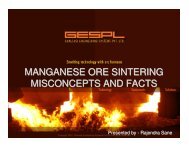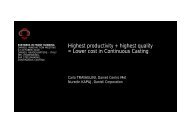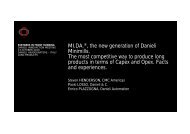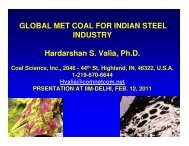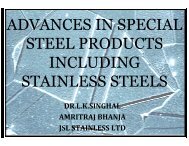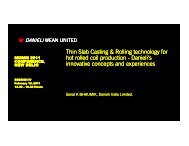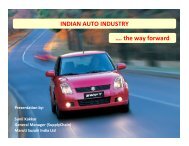roll pass design evauluation using software application - IIM
roll pass design evauluation using software application - IIM
roll pass design evauluation using software application - IIM
You also want an ePaper? Increase the reach of your titles
YUMPU automatically turns print PDFs into web optimized ePapers that Google loves.
ROLL PASS DESIGN EVAULUATIONUSING SOFTWARE APPLICATIONARINDAM MUKHERJEEPROJECT MANAGEMENT CELLUNDP/GEF PROJECT (STEEL)
OBJECTIVE OF ROLL PASS DESIGN Steel sections are generally <strong>roll</strong>ed in several <strong>pass</strong>es, whose number isdetermined by the ratio of initial input material and final cross s sectionof finished product. The cross section area is reduced in each <strong>pass</strong> and form and size of thestock gradually approach to the desired profile.
ROLLING PROCESS Steel <strong>roll</strong>ing consists of <strong>pass</strong>ing the material, usually termed the tstock,between two <strong>roll</strong>s driven at the same peripheral speed in oppositedirections (i.e. one clockwise and one anti-clockwise) and so spacedthat the distance between them is somewhat less than the thickness ofthe section entering them. In these circumstances the <strong>roll</strong> grip the material and deliver it reducein thickness, increased in length and probably somewhat increased d inwidth.
Production of correct profile withintolerance limits with good surface finish(free from surface defects). Maximum productivity at lowest cost. Minimum <strong>roll</strong> wear. Easy working. Optimum energy utilization.
Shape of sections in a particular <strong>pass</strong>es must ensure afree metal flow in the <strong>roll</strong> gap/groove. Appropriate taper/groove angle in <strong>pass</strong> must be selectedin order to avoid metal jamming in <strong>roll</strong>s.TYPE OF PASS% TAPERRoughing <strong>pass</strong> 6 to 15Forming <strong>pass</strong> 3 to 10Finish <strong>pass</strong> 0.5 to 3.0%
Groove angle for box <strong>pass</strong> should be 8 to 10 0 . Relief radius for box <strong>pass</strong> should be 10 mm. Groove angle for diamond <strong>pass</strong> should be > 90 0 . Relief radius for diamond should be around 18 mm . Groove angle for square <strong>pass</strong> should be 45 0 . Bottom angle for square <strong>pass</strong> should be around 90 0 . Relief radius for square <strong>pass</strong> should be 5mm . Groove angle for oval should be 60 0 . Relief radius for oval should be 5mm. Groove angle for intermediate round <strong>pass</strong> should be 60 0 . Groove angle for intermediate finish round <strong>pass</strong> should be 30 0 . Bottom radius for rounds is ½ of dia. Relief radius for rounds is 1/5 th of bottom radius . Relief radius for rounds in finish <strong>pass</strong> should be 1.5. Fitting from oval to round should be 0.3 to 0.7. For ovals width to height ratio should be < 3.0.
The number and arrangement of <strong>pass</strong>es in particular <strong>roll</strong> standshould assure the most uniform possible exploitation of all the<strong>pass</strong>es in each stand. Uniform draught in last <strong>pass</strong>es & different draught in early forming<strong>pass</strong>es of profile , where the section is large & metal is hot. Draught should be distributed so as to ensure as far as possibleuniform wear and to avoid overloading of drive installations and<strong>roll</strong>s .
• Rolls should easily grip the material being <strong>roll</strong>ed .Rolls FinishMax. Angle of Bite (in degrees) with reference to speed of mill0 0.5 1 1.5 2 2.5 3 3.5Smooth 25.5 24.5 23.5 22.5 19.5 16 12 9Edged <strong>pass</strong>es 29 27.5 26 24.5 21 17 12 7Ragged 33 32 31 30 28 26 24 21• Pass filling should be correct.
The Fitting parameter should be 0.3 < Fitting < 0.7 to avoidproblems with bad surface quality and bad wearing conditions of thegroove bottom.
An optimum number of <strong>pass</strong>esshould be used.If, Too greater in number Lower theout put of the <strong>roll</strong> standToo smaller in number Causeexcessive <strong>roll</strong> wearDanger of <strong>roll</strong> fracture or <strong>roll</strong>ing defect
Total Elongation Coefficient λ tat Different Reductions relative to No. of Passesλ tfor percentage reduction ofPass No. 5 10 15 20 25 30 35 401 1.053 1.111 1.177 1.250 1.333 1.429 1.538 1.6672 1.108 1.235 1.384 1.563 1.777 2.042 2.365 2.7793 1.167 1.372 1.628 1.953 2.369 2.918 3.638 4.634 1.228 1.524 1.915 2.441 3.157 4.170 5.595 7.725 1.293 1.694 2.253 3.052 4.209 5.96 8.606 12.876 1.361 1.883 2.650 3.815 5.610 8.52 13.24 21.57 1.432 2.092 3.117 4.77 7.48 12.17 20.36 35.88 1.508 2.324 3.667 5.96 9.97 17.39 31.31 59.69 1.587 2.582 4.313 7.45 13.29 24.8 48.15 99.410 1.670 2.868 5.073 9.31 17.71 35.5 74.06 165.712811 1.758 3.187 5.967 11.64 23.61 50.7 114 276.243212 1.851 3.540 7.019 14.55 31.5 72.5 175 460.497413 1.948 3.933 8.256 18.19 42.0 104 269 767.649214 2.050 4.370 9.711 22.74 55.9 148 414 1279.67115 2.159 4.855 11.423 28.42 74.6 212 637 2133.21216 2.272 5.394 13.445 35.53 99.4 302 980 3556.06417 2.392 5.992 15.824 44.41 132 432 1508 5927.95918 2.518 6.658 18.625 55.51 177 617 2319 9881.90819 2.651 7.397 21.922 69.39 235 882 356620 2.790 8.218 25.802 86.74 314 1261 548421 2.938 9.130 30.369 108.4 418 1802 843522 3.092 10.143 35.744 135.5 558 257523 3.255 11.269 42.071 169.4 743 367924 3.427 12.520 49.497 211.8 991 525725 3.607 13.910 58.257 264.7 1321 7513CALCULATION FOR NO. OFPASSESInput Size = 200x200 mmFinish Product = 50x50 mmλ t =200x200/50x50 = 16With 25 % Redn. In every <strong>pass</strong> after9 th <strong>pass</strong> λ t = 13.29 and after 10 th <strong>pass</strong> λ t=17.71.10 <strong>pass</strong>es will be sufficient with redn. Somewhtatless than 25 %.Last <strong>pass</strong> = 5% ,λ t = 1.053Preleader =10% ,λ t = 1.111=1.053x1.111=1.168λ t= 16/1.168 = 13.7With 30% redn. 13.7 can be achieved after 7 <strong>pass</strong>or we can say 8 th <strong>pass</strong>.
EVALUATION BASED ON ABSOLUTE REDUCTIONPass Pass Initial Initial Initial Final Final Final Mean Abs. Pass wiseno Shape width height Area width height Area width red. Power(Kw)Required forDeformationB H Fo b h F1 Bm dhmm mm mm2 mm mm mm2 mm mm1 Box 100.00 100.00 9940.00 110.00 80.00 7920.00 105 20 62.322 Box 110.00 80.00 7920.00 125.00 58.00 6525.00 118 22 89.013 Square 58.00 125.00 6525.00 72.00 72.00 5184.00 65 53 118.124 Box 72.00 72.00 5184.00 86.00 50.00 3870.00 79 22 68.485 Square 50.00 86.00 3870.00 56.00 56.00 3136.00 53 30 61.506 Box 56.00 56.00 3136.00 66.40 40.00 2376.00 61 16 43.827 Square 40.00 66.40 2376.00 40.00 40.00 1600.00 40 26 44.708 Oval 40.00 40.00 1600.00 48.00 28.00 1055.04 44 12 27.869 Square 28.00 48.00 1055.04 29.00 29.00 841.00 29 19 27.3710 Oval 29.00 29.00 841.00 36.00 20.00 565.20 33 9 18.4311 Square 20.00 36.00 565.20 20.00 20.00 400.00 20 16 18.9312 Oval 20.00 20.00 400.00 24.00 15.00 282.60 22 5 28.6313 Square 15.00 24.00 282.60 14.50 14.50 210.25 15 10 35.0914 Oval 14.50 14.50 210.25 18.00 9.50 134.24 16 5 64.7215 Round 9.50 18.00 134.24 12.00 12.00 113.04 11 6 49.9516 Oval 12.00 12.00 113.04 15.00 7.50 88.31 14 5 98.8017 Round 7.50 15.00 88.31 10.00 10.00 78.50 9 5 68.4218 Oval 10.00 10.00 78.50 12.00 6.30 59.35 11 4 81.4819 Round 6.30 12.00 59.35 8.00 8.00 50.24 7 4 55.38
+T Risk of tilting in the next groove due to too large width-T Risk of tilting in the next groove due to too small width +F The ratio Bar Edge/Groove Bottom Diameter of the next groove is >0.7+O Overfilling (Bar width>Groove Width)+W Width of finishing dimensions is more than 1.5% TOO LARGE-W Width of finishing dimensions is more than 1.5% TOO SMALL+D Sb,Db or Hb of finishing dimensions is more than 1.5% Too Large-D Sb,Db or Hb of finishing dimensions is more than 1.5% Too Small+L Loop Growth by repeater <strong>roll</strong>ing is TOO LARGE . Tension by block<strong>roll</strong>ing is TOO SMALL-L Loop Growth by repeater <strong>roll</strong>ing is TOO SMALL . Tension by block <strong>roll</strong>ingis TOO LARGE-N Motor revolution is below the base revolution . Full power is not available
RollPass Initial Initial Initial Final Final Final Mean Abs. dia. Work RollLineaAnglCoeffr e of RollingMetalCoeff Coeffof ofRelativ Meane Sigma sp.RollingRolling Power TorquePower for TotalCumofwidth height Area width height Area width red. max. dia rpm speedbitedraught temp comp.frictionviscositydeformrate<strong>roll</strong>ingpr. force torquefordeform.forfrictionfriction power PowerB H Fo b h F1 Bm dh Dk Dwk n V < /u t F n/ U o- p P Ma Na Mn Nn N Nkgf s/m kgf s/m kgf/mno mm mm mm2 mm mm mm2 mm mm mm mm rpm m/s deg. o C Comp. 2 1/s 2 m 2 T kgm kW kgm kW kW kW1 100.00 100.00 9940 105 75 7875 103 25 460 377 90 0.42 19 1.12 1125 2.30 0.49 0.03 1.60 7.70 8.98 69.82 5029.41 90.88 1059.82 1.95 92.832 105.00 75.00 7875 109 53 5724 107 22 460 399 90 0.42 18 1.17 1113 2.30 0.49 0.03 2.05 6.60 8.14 61.93 4184.92 77.03 940.07 1.73 78.763 53.00 109.00 5724 92 92 4265 72 17 460 380 90 0.42 16 1.16 1101 2.30 0.50 0.03 1.15 6.88 7.89 35.83 2133.64 48.91 543.95 1.00 49.914 65.00 65.00 4265 95 50 2980 80 15 460 402 90 0.42 15 1.20 1089 2.30 0.51 0.03 1.88 7.15 8.99 42.24 2356.80 50.57 641.15 1.18 51.755 50.00 95.00 2980 65 65 2025 58 30 460 396 90 0.42 21 1.21 1077 2.30 0.51 0.03 1.91 7.43 8.91 42.56 3355.59 68.56 646.03 1.19 69.756 45.00 45.00 2025 66 36 1487 55 9 460 412 90 0.42 11 1.17 1065 2.30 0.52 0.03 2.07 7.71 10.26 25.79 1114.91 23.88 391.57 0.72 24.607 36.00 66.00 1487 46 46 1056 41 20 460 412 90 0.42 17 1.19 1053 2.30 0.52 0.03 2.24 7.98 10.32 28.71 1851.96 37.53 435.88 0.80 38.338 32.50 32.50 1056 48 19 731 40 13 460 424 90 0.42 14 1.20 1041 2.30 0.53 0.04 3.90 8.26 13.16 29.06 1515.63 32.66 441.21 0.81 33.479 19.00 48.00 731 33 33 527 26 15 460 426 90 0.42 15 1.18 1029 2.30 0.54 0.04 2.73 8.53 11.98 18.41 1043.51 23.81 279.54 0.52 24.3210 23.00 23.00 527 36 14 396 30 9 460 436 90 0.42 11 1.15 1017 2.30 0.54 0.04 4.53 8.81 15.62 20.97 906.38 19.99 318.33 0.59 20.5711 14.00 36.00 396 25 25 306 19 11 460 435 90 0.42 13 1.14 1005 2.30 0.55 0.04 3.09 9.09 13.73 13.53 653.94 15.09 205.42 0.38 15.47 367.6112 17.50 17.50 306 27 11 266 22 7 330 312 180 1.70 11 0.32 993 2.30 0.55 0.04 23.91 9.36 16.40 11.91 373.78 45.36 129.74 1.33 46.6913 10.89 26.50 266 19 19 179 15 8 330 312 180 1.70 12 1.22 981 2.30 0.56 0.04 16.05 9.64 14.44 7.62 256.44 32.78 82.96 0.85 33.63 80.3214 13.36 13.36 179 19 9 135 16 4 260 247 290 4.40 11 1.15 969 2.30 0.57 0.04 72.09 9.913 17.17 6.62 149.61 58.31 56.76 1.92 60.2415 9.00 19.00 135 15 15 106 12 4 260 257 290 4.40 10 1.13 957 2.30 0.57 0.04 47.16 10.189 15.16 4.23 94.46 38.94 36.30 1.23 40.17 100.4116 10.43 10.43 106 16 7 90 13 3 280 271 380 7.56 9 1.08 945 2.30 0.58 0.05 131.59 10.465 19.98 5.66 115.20 73.81 52.29 2.82 76.6317 7.15 16.00 90 10 10 78 9 6 280 278 380 7.56 10 1.08 933 2.30 0.58 0.05 120.34 10.741 18.99 4.72 129.96 80.21 43.61 2.35 82.56 159.19
CHARACTERISTICS OF A GOODROLL PASS DESIGNTo ensure a profile with a smooth surface and correct dimensionswithin the stipulated limits of standards.To ensure the minimum expense in terms of energy, power and <strong>roll</strong>consumption,To give deformation in such a way and at stages to have minimuminternal stresses in the finished product.To create a simple and convenient work culture at stand, minimizingingthe manual operation to the minimum possible extent and to introducethe automation of technological process.To optimize the number of <strong>pass</strong>es required for <strong>roll</strong>ing to reduce thetotal <strong>roll</strong>ing time cycle, with minimum time spent for changing and aadjusting of <strong>roll</strong>s.
ROLL PASS DESIGN PROCESSDetermination of finished product dimensions.Calculation of steel contraction factor.Calculation of average elongation and number of <strong>pass</strong>es required.Determination of appropriate <strong>pass</strong> shapes.Calculations of <strong>roll</strong>ing power required and mechanical equipmentloads.Determination of <strong>pass</strong> progression and family tree.Drawing of detailed <strong>pass</strong> shapes.
TYPICAL HEATING SCHEDULEGroupType of steelTemperature,OCICarbon and low-alloy steels (up to 0.45% C)1200-12201220IICarbon, low-and medium alloy steels (up to 0.65%C)1180-12001200IIICarbon and medium alloy steel (up to 0.9%C)1140-11601160IVCarbon and alloy steel; tool and bearing steel (up to 1%C)1120-11401140VVICarbon and medium alloy steel; tool and high manganesesteels (up to 1.3%C)Nichrome and stainless steels1100-112011201200-12201220VIIHigh-speed steels1180-12001200
arin.mukherjee@undpgefsteel.gov.in09910671956



